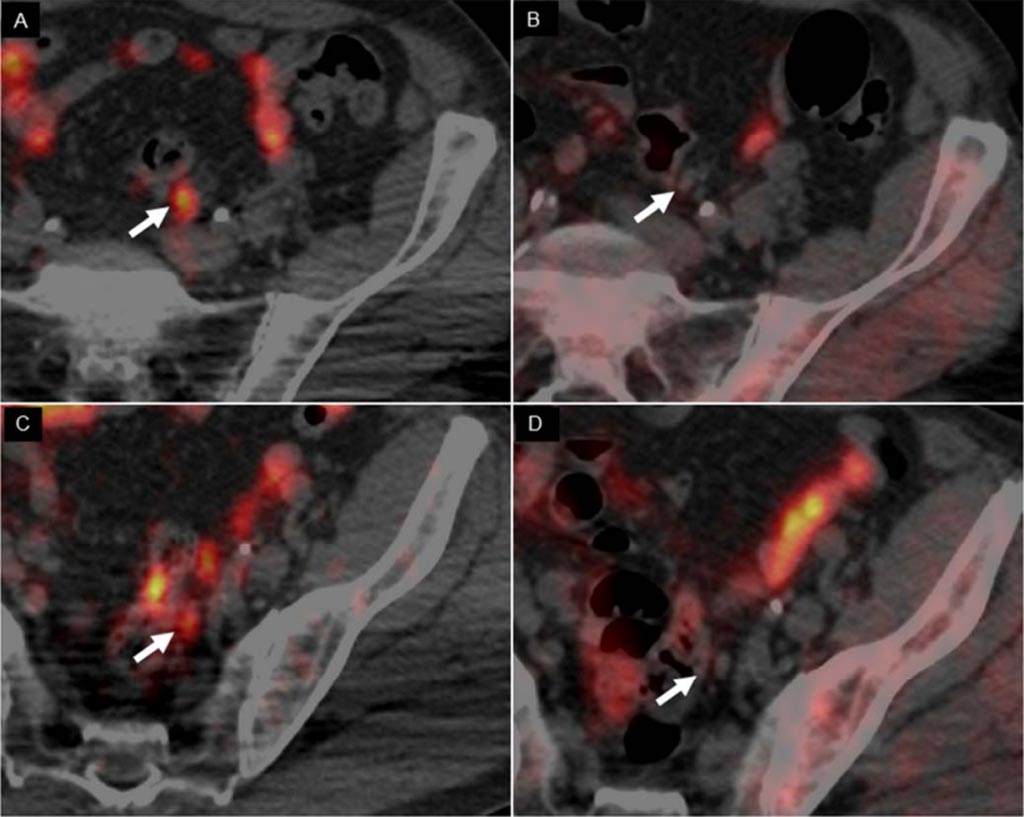Novel PET Imaging Agent Targets Copper Atoms
By MedImaging International staff writers
Posted on 21 Mar 2018
A novel positron emission tomography/computed tomography (PET/CT) imaging agent that traces copper accumulation in tumors can help detect prostate cancer (PC) recurrence, according to a new study.Posted on 21 Mar 2018
Researchers at Galliera Hospital (Genoa, Italy), Humanitas Research Hospital (Milano, Italy), and other institutions conducted a study that prospectively evaluated 50 PC patients with relapse after surgery or external-beam radiation therapy (EBRT), as identified by rising prostate-specific antigen (PSA) levels. All patients underwent 64CuCl2 PET/CT, 18F-choline PET/CT, and multi-parametric magnetic resonance imaging (mpMRI) within a 15-day period in order to evaluate and compare the biodistribution, kinetics, and radiation dosimetry of 64CuCl2 in humans.

Image: 64CuCl2 PET/CT images reveal two positive small lymph nodes (A, C), whereas 18F-Choline PET/CT (B, D) is negative (Photo courtesy of Arnoldo Piccardo/ Galliera Hospital).
Experienced readers interpreted the images, and the detection rate of each imaging modality was then calculated. Histopathology, clinical or laboratory response, and multidisciplinary follow-up were used to confirm the site of disease. The results revealed that maximum 64CuCl2 uptake at PC sites relapse was observed one hour after tracer injection. 64CuCl2 PET/CT proved positive in 41 of 50 patients, with an overall detection rate of 82%; detection rates of 18F-choline PET/CT and mpMRI were 56% and 74%, respectively. The study was published in the March 2018 issue of The Journal of Nuclear Medicine.
“This study determined that the biodistribution of 64CuCl2 is more suitable than that of 18F-Choline for exploring the pelvis and prostatic bed,” said lead author Arnoldo Piccardo, MD, of Galliera Hospital. “Early detection of prostate cancer relapse may improve the clinical management of patients, for example implementing early salvage radiotherapy. Larger trials with this PET tracer are expected to further define its capabilities and role in the management of prostate cancer.”
Copper-64 is a positron-emitting isotope of copper, with applications for molecular radiotherapy and PET. The coordination chemistry of copper allows for its reaction with a wide variety of chelator systems that can be linked to antibodies, proteins, peptides, and other biologically relevant small molecules. The longer half-life of 64Cu delivers optimal bio-distribution of slower clearing agents, such as monoclonal antibodies, nanoparticles, and higher molecular weight polypeptides requiring longer imaging times.
Related Links:
Galliera Hospital
Humanitas Research Hospital














